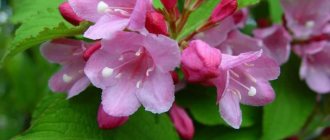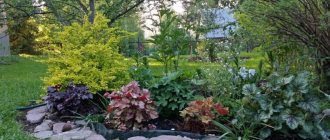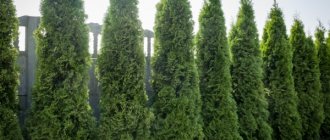If in the spring, when there is no greenery yet, and the grass is just beginning to appear, you see a bush covered with bright yellow small flowers from the base to the crown, this is forsythia, which, like the snowdrop, is considered a symbol of spring. It will bloom for 1.5-3 weeks, after which it will begin to become covered with leaves. After flowering, if gentle pruning is carried out in a timely manner, maintaining the shape of the bush, the plant looks no less decorative - in a composition with flowering and deciduous perennials it looks very harmonious and picturesque. In some varieties, the foliage changes color in the fall, and the shrub looks original until late autumn.
2.Description - what the bush looks like
As a true harbinger of spring, forsythia (or forsythia) impresses with the splendor of its bright yellow flowers that bloom before the leaves form in early spring. The genus includes 11 plant species.
These fast-growing deciduous shrubs or even low trees have erect or gracefully arched shoots covered with light brown bark.
The leaves are dark green, with a jagged edge, and can turn reddish-purple or yellow in the autumn months. The leaf blades are oblong-oval, arranged oppositely, on short petioles.
↑ Up,
The main decoration of the plants are bell-shaped golden-yellow (sometimes white) flowers with a diameter of up to 3-4 cm, blooming in early spring, immediately after the snow melts.
achenes form at the site of each bud .
The plant received its original name “Forsythia” in honor of the Scottish botanist William Forsyth, but then it was slightly modified. This is the man who first brought forsythia to Europe in the 18th century. The plant became quite widespread in gardens a little later - around 1833.
↑ Up,
Height . The height of the plant depends on the variety and pruning and can range from 90 cm to 6 m. Currently, many compact varieties have been developed.
4.Planting and caring for forsythia in the garden
To grow forsythia, it is worth providing a well-lit area or slight partial shade. With a lack of sunlight, flowering may become less abundant - the sun's rays should hit the plants for at least 6 hours a day.
The bush should not be placed in places where rain and melt water accumulates - the plants may rot. It does not like this type of exposure to strong winds - the area must be protected from its gusts.
↑ Up,
4.1.How and when to plant in open ground
Planting in open ground is carried out 2 times a year - in early spring or in the first half of September. Before the onset of night frosts, plants will need time to adapt to a new location and form additional roots. Plants planted in early autumn, in addition to adaptation, will also have time to lay flower buds and will delight their owners with flowering next spring.
The area is carefully dug up and weeds are removed. Depending on the planned planting scheme and the height of the plants, planting holes are prepared, leaving between them a distance of 90 - 120 cm. When grown as a hedge, the distance is reduced to 60 - 80 cm, and in single plantings the distance between plants can even be a few meters.
The depth and width of the planting holes should be 2 times greater than the root ball of the plants - approximately make holes 60 - 70 cm deep and wide.
↑ Up,
At the bottom of the holes, a drainage layer is arranged in the form of crushed stone about 15 - 20 cm high and river sand another 7 - 10 cm high - this will allow excess moisture to be quickly removed from the roots after watering.
A nutrient layer consisting of humus or soil mixed with a good amount of manure can be placed on the drainage.
Depending on the form in which the plant was purchased, the seedling is installed in the hole along with the root ball (if it was in a shipping container when purchased) or a small mound is made at the bottom of the hole and the plants are placed on top of it, straightening the roots and not allowing them to curl. or be directed upward.
In a circle, the bush is sprinkled with earth mixed with wood ash and coal, humus and manure, which is then compacted well. After planting, the forsythia should be at the same depth as it was in the shipping container - the root collar should be at ground level.
↑ Up,
After planting, the plants are watered with plenty of water. If, after watering, the soil has settled strongly and voids have formed, then add the required amount of soil and compact it again.
The bases of the shrubs are mulched with scrapped fallen leaves (if planting is carried out in the fall), small pieces of bark or sawdust and straw or mown grass. Mulch is needed to control weed growth and prevent water from evaporating too quickly after watering.
In the first month after planting, the plants are watered evenly, preventing the soil from drying out. Tall seedlings should also be provided with support.
↑ Up,
4.2.Soil and fertilizing
Forsythia tolerates a fairly wide range of soils with an acidity level from 5.0 to 8.0. Preferred for shrubs are soils enriched with nutrients and easily permeable to moisture and air.
River sand is added to heavy clay soils to improve structure and moisture permeability. For additional nutrition, leaf and turf humus and well-rotted cow or horse manure are mixed into the soil for planting and growing.
Superphosphate granules are added from mineral fertilizers.
↑ Up,
In the first year after planting, plants do not require fertilizers, and in the second and subsequent years, fertilizing is carried out 2-3 times per season.
The first application of fertilizers is carried out in early spring - still on the snow cover, scattering potassium-phosphorus mixtures or laying well-rotted manure. The second feeding can be done in mid-summer and the last one, in late August - early September, is done for the abundant formation of flower buds.
Plants love soils with a high lime content - sprinkle the soil for planting with lime milk, and also mix wood ash or pieces of coal into the soil.
↑ Up,
4.3. Shelter for the winter
Not all varieties can be preserved in harsh winters with little snow. You should not plant species such as F. dark green, Giralda, drooping in the conditions of the Middle Zone. European, ovoid, and intermediate forsythia have good frost resistance. Among other things, intermediate forsythia easily tolerates a polluted urban atmosphere and is often planted on city streets.
Taking into account the fact that plants overwinter with buds set in autumn, when frost occurs, flowering is the first to suffer. If the plants overwintered in harsh conditions without shelter, then the flowers can bloom in the spring only at the foot of the bush - where it was covered with snow. Alternating thaws and frosts in the winter months have a negative effect on flower buds.
↑ Up,
It is worth choosing a breathable shelter - for example, non-woven agricultural material. Under ordinary plastic film, plants can dry out when the temperature begins to cross the zero mark several times during the day.
Before the first autumn frosts, the shrub is hilled up high, soil is sprinkled on the roots, fallen leaves are sprinkled on the bases of the plants - the thickness of the layer can reach 10 - 15 cm.
The branches are tied with a rope and, if possible, bent to the soil, trying not to break. From above, low plants are covered with spruce branches, and large ones are covered with non-woven material.
↑ Up,
If it is not possible to bend down the branches, then a light frame is built over the bushes and non-woven material is stretched over it. Immediately after the first snowfall, the bushes can be additionally sprinkled with snow.
As soon as the snow begins to melt in the spring, the shelter is removed. If the winter is characterized by a large amount of snow, then the plants can be left for the winter without shelter.
↑ Up,
4.4.Pruning and formation of forsythia
Until the age of 4 - 5 years, the plants are not touched, allowing them to develop independently. Mature forsythia requires timely pruning to maintain an attractive, compact shape and to remove old and diseased shoots. Without trimming, bushes can become loose and disheveled.
When pruning, you should pay attention to the fact that buds form on last year’s branches and their removal will inevitably negatively affect flowering. Formative pruning is carried out immediately after flowering - long faded branches are shortened by half or even 2/3 of the length, leaving only 2 - 3 buds at the base. The cut point should be no more than 5 mm. above the leaf node and pass at a slight angle.
You should not start a bush and then try to correct all the flaws in one pruning - the formation must be carried out constantly and little by little.
↑ Up,
All old, dry and diseased branches are cut out at the base with a sharp and sterile pruner or garden knife, allowing young branches to grow. Shoots damaged by frost are shortened to healthy tissue in early spring.
With the help of drastic pruning, adult plants over the age of 5 - 7 years can be rejuvenated. Rejuvenation is carried out every 4 - 5 years, leaving only 15 - 20 cm of growth and removing almost the entire crown. They also leave 4 - 5 main skeletal branches, which will grow over the next season and form a new form of bush.
If a cardinal haircut is used frequently, then forsythia will respond to it with exuberant growth and very modest flowering. After a rejuvenating haircut, since thick shoots are often cut off, the wound surface is covered with garden varnish to prevent infections and rot.
↑ Up,
4.5.Watering
During the first time after planting, young plants are watered regularly, keeping the soil moist but not swampy. Mature forsythia will tolerate drought more easily than large amounts of moisture.
Water the plants quite rarely, but abundantly, trying to bring moisture directly under the roots. You should not water during the daytime - the sun's rays hitting the leaves and passing through droplets of moisture can cause burns on the leaves. In addition, during the day, in hot weather, most of the water will evaporate from the surface of the soil, without having time to be absorbed into the depths.
↑ Up,
The fact that plants lack moisture can be immediately judged by leaf blades that have lost turgor. Severe drying out should not be allowed, as this will leave the plants with no strength left to set flower buds for the next year.
After watering, the soil in the tree trunk circle is loosened deeply - 20 - 25 cm, weeds are removed and the mulch layer is renewed. Loosening allows the roots to breathe, allowing sufficient oxygen to reach them.
↑ Up,
Plant conditions
Deytsia (photo and description of the shrub will help create the right conditions for growing the plant) is undemanding in the choice of soil and does not require special maintenance conditions, but it is necessary to adhere to basic care recommendations.
Lighting
Deytsia loves lighted areas, but being under the scorching sun all day can lead to burns. The best option is a place that will be brightly lit in the first half of the day and hidden in partial shade in the afternoon.
Temperature
In places with shade from the midday heat, the “eastern beauty” feels great in the summer heat. The frost resistance of Deytsia depends on the species. Most varieties can withstand winter temperatures down to -25o, some hybrids can withstand even more severe frosts.
Deytsia does not tolerate snow and frost well, so it needs shelter for the winter.
The combination of low temperatures and lack of snow cover is dangerous for Deytsia. When the ground part freezes, the plant has the ability to grow new shoots from the roots and recover, and freezing of the root threatens the loss of the bush. A winter shelter will help you avoid such trouble.
Soil and drainage
The best soil for planting Deytsia is nutritious and loose, with neutral acidity. A drainage layer of sand or small pebbles is required. Suitable composition: leaf soil, humus, sand in a ratio of 2:2:1.
Watering
Deutia (the photo and description of the shrub will prompt the correct choice of planting site) is more likely to withstand prolonged drought than stagnation of water at the roots. For this reason, the bush should be watered no more than once a week in the absence of natural precipitation.
The action should be watered once a week
The one-time water requirement for an adult plant is 1 bucket. After watering, it is advisable to loosen the soil around, but so as not to damage the surface roots. If the bush is surrounded by mulch, this action is not necessary.
5. Application in landscape design
Depending on the type, forsythia can be used as a bright, single blooming accent in a flower bed or planted as a group of plants at once. Some varieties can be used for vertical gardening, shading and at the same time decorating gazebos and verandas. Low-growing plants decorate rock gardens.
Early and abundant flowering of forsythia does not go unnoticed by bees and other beneficial insects. At a time when few plants have acquired foliage, the shrub already serves as an excellent honey plant and feeds insects hungry during the winter.
↑ Up,
From these shrubs you can build a hedge, which during the spring will delight the eye with abundant flowering, and in the fall it will decorate the garden with crimson and yellow foliage.
Varieties with long drooping shoots can be used as an attractive living arch, providing the plants with arching trellises.
Interestingly, forsythia bushes have a long lifespan and can decorate the garden for 45 - 50 years.
Forsythia branches in January - February can be used for cutting - once in warm conditions they will open their buds within 10 days.
↑ Up,
6.Transplant
It is not recommended to change the location of adult plants; in addition, many forsythia exceed 1.5 - 2 m in height and replanting them is simply difficult.
Of course, it is better to immediately plant a shrub in a permanent place, but young plants up to 3-4 years old, if necessary, can be transferred to a new place after complete flowering - at the end of spring.
It is better to transplant on a cool and cloudy day - in such conditions it will be easier. The bushes are dug around the perimeter, making a circle equal to the diameter of the crown - this is the distance the root system diverges.
↑ Up,
In order to reduce moisture loss, some of the branches are removed using pruners. The bushes are dug up together with a lump of earth, laid on burlap or film to keep the root ball intact, and transferred to a new area, being careful not to destroy it - they are transferred. Transshipped specimens adapt faster and begin to grow. IN
In the first week after transplantation, it is advisable to provide shelter from direct sun and promptly water the disturbed bushes. In the first winter after transplantation, shelter will be mandatory for such forsythias.
↑ Up,
Fertilizers for plants
Feeding Deytsia is carried out in the first half of summer, before the buds appear and during flowering. After the end of the active growing season, closer to autumn, fertilizing is stopped, since an overly fertilized plant cannot easily tolerate the cold.
Mineral mixtures
Complex mineral fertilizers are sprinkled under each bush in an amount of 120-150 g. This is done 2 times - at the beginning of bud swelling and during vigorous flowering.
Organic fertilizers
The soil around the bush is fertilized with organic fertilizers monthly.
For this use:
- liquid manure - 3-4 liters for each bush;
- compost mixed with wood ash.
7. Propagation of forsythia
There are many propagation methods, and most of them are quite easy for forsythia. Plants reproduce vegetatively - by cuttings, air layering or division during transplantation.
Seed propagation will be much longer and more labor-intensive; it is most often used by breeders to develop new varieties.
↑ Up,
7.1.Cuttings
Numerous cuttings obtained during spring pruning easily take root with minimal time and labor. Shoots that are half lignified and covered with bark at the bottom are suitable for propagation. The cuttings can reach 12–15 cm in length and contain 2–3 internodes.
The lower pair of leaves is removed, and the bases of the cuttings are treated with rooting powders. The remaining leaf blades can be shortened by a third of the length with ordinary scissors to reduce moisture loss.
Small flower pots are filled with soil consisting of humus, a small amount of peat, with the addition of up to half the volume of a mixture of river sand and perlite.
↑ Up,
The cuttings are immersed 1 - 2 cm deep at a slight angle into the soil, which is kept evenly moist using a sprayer.
The seedlings are covered with a plastic bag on top to maintain high air humidity and placed in a well-lit place, but inaccessible to direct sunlight. Every day the bag is removed and the cuttings are ventilated, at the same time removing water condensation.
Within 2 - 4 weeks, you will notice the appearance of the first new shoots and leaves - this means that the first roots have appeared under the surface of the soil. The shelter is completely removed at this time.
In September, such cuttings can be planted in the garden and in the first year they can be carefully covered with fallen leaves or spruce branches.
↑ Up,
Completely lignified shoots can also be rooted, but this is done later - at the end of August - the first half of September. The lower cut is made with a garden knife so that it runs at an angle of about 45 degrees, the upper end of the cutting should be straight.
It is believed that the percentage of rooting is higher for cuttings cut from the base of the shoots - they retain a greater supply of useful substances.
Such cuttings are planted immediately in open ground, in small planting holes 20-30 cm deep with a drainage layer of river sand at the bottom. The drainage layer can reach up to 5 cm in height. The cuttings are immersed in the soil to 2/3 of the height, watered in a timely manner and covered with leaves before the onset of night frosts.
When the snow melts at this place in the spring, the cuttings are opened and grown until the fall, and then planted in a permanent place.
The first buds will decorate such plants at the age of 2 - 3 years.
↑ Up,
7.2.Formation of air layers
One of the easiest and therefore very common methods of propagating forsythia.
At the end of spring or beginning of summer, the lateral branches located close to the soil surface are slightly scratched from the bottom (then roots will appear in this place). Next, such shoots are bent to the ground or placed in a small trench and pinned on top with wire.
The layering is buried on top of the layer with soil, leaving the top of the shoot above the soil surface for vegetation. The land in this place is watered in a timely manner, not allowing it to dry out.
After 3 - 4 weeks, young branches will appear from the ground. Such cuttings are separated from the mother bush next year - in the spring. In the warm season, separated cuttings are cared for as adult plants; in the fall they are covered in preparation for the onset of cold weather.
The first flowering will occur in the third year - in the spring.
↑ Up,
7.3.Growing from seeds
This propagation method is suitable only for experienced and patient gardeners. It will take about 5 to 7 years for the first buds to appear on young branches of plants grown from seeds.
It is not advisable to propagate varietal plants by seeds - the declared characteristics may not be inherited by the daughter bushes.
You can use the seeds you collected yourself - they are removed from the ripe, brown seed pods and slightly dried.
In September, shallow furrows are prepared in the area and seeds are sown in them. From above, such an area is covered with dry leaves or spruce branches before night frosts. The first shoots will appear in the spring.
↑ Up,
You can sow in spring, but to increase germination it is worth stratifying. The dried seeds are placed in small paper bags and placed in the vegetable compartment of the refrigerator, where they are stored during the winter months.
At the end of February - beginning of March, seedling boxes or small greenhouses with soil are prepared, into which the seeds are sown. On top of the seeds cover a layer of soil about 1 cm thick.
The soil surface is thoroughly moistened with a spray bottle and the seedlings are covered with a plastic lid or covered with a transparent film. The crops are ventilated daily, gradually increasing the time.
↑ Up,
With the appearance of the first shoots, which usually occurs within 4 - 5 weeks, the shelter is completely removed.
When 2 - 3 true leaves are formed on each bush, a dive is carried out - the forsythia is planted in small but separate flower pots. 10 - 12 days after diving, you can feed the bushes for the first time with a weak solution of nitrogen fertilizers.
Bushes grown from seeds are planted in the garden at the age of 3 or more years.
↑ Up,
7.4.Dividing the bush
For division, you should choose only young plants aged 4 - 5 years, not older. Unfortunately, when dividing, there is a high probability of death of all the divisions, so this method is rarely used.
The bushes are dug out of the ground and shaken off any remaining soil. The root system is inspected and, if necessary, old and rotten roots are trimmed to healthy tissue using pruning shears or a garden knife.
Multi-stemmed bushes are divided into 2-3 parts using a knife, making sure that each has its own root system.
The wounds are treated with charcoal powder for drying and disinfection. The divisions are planted in separate holes.
↑ Up,
Wintering action
The plant does not survive harsh winters as problem-free as many Russian perennials. Its shoots remaining on the surface can freeze heavily right up to the very level of the snow cover, however, in the spring they can begin to grow back from this very place. Alas, this is fraught with the fact that during this season the deutzia will no longer bloom, since it is primarily the young shoots that are affected by the cold, on which flower buds are laid next year. Therefore, caring for the plant in the fall requires a special approach.
The deutia bush can be covered, but the idea is complicated by the fragility of the hollow branches of the second year. Young bushes are carefully bent to the ground and arcs or poles are placed over them crosswise, on which spruce branches, foliage and other insulating materials are placed on top. The design will protect the plant from the load of the shelter and the snow covering it and from the cold.
It will not be possible to tilt an old bush this way due to the fragility of the branches - it will immediately break, so a different tactic is used here. Deutia's own foliage is considered as protection against frost, so they begin to cover it even before the leaves fall. The shoots are very carefully tied together with a wide rope (you can use scraps of old bed linen) and a bag sewn from any covering non-woven material (optimal density 60) is placed on the bush. The structure is fixed with ordinary clothespins. Under such cover, flower buds are also better preserved, since in this crop they are prone to drying out.
A frozen deutia bush is usually easily restored, but for successful flowering you will have to wait another year.
8. Diseases and pests
Fungal diseases can cause late blight if the shrub grows in poorly drained soil with stagnant moisture. Bacterial wilt. Moniliosis. Leaf blades become light and even yellow if there is excess calcium in the soil. Plants rot when constantly flooded or planted in flooded lowlands.
Among insect pests, nematodes and aphids can attack plants.
↑ Up,
Features of landing
Autumn planting of forsythia
A small hole is prepared in accordance with the general rules. The depth of planting should not exceed more than 30 - 40 cm. Moreover, each bush should be planted no closer than one and a half meters to another.
Ideal materials for hole preparation are:
- drainage consisting of crushed stone or bricks, crushed into small fragments (thickness about 20 cm);
- sand layer (about 10 cm thick);
- soil mixture composed in accordance with generally accepted proportions (wood ash is first added to it).
Prepared cuttings or grown bushes are planted and covered with soil, compacted tightly. A newly planted plant requires abundant watering. When planting in the autumn, you need to mulch and cover with material that will allow the shrub to “breathe”. This will allow the buds to develop freely and not rot during short-term winter thaws.
9. Varieties and types of forsythia:
9.1.Intermediate or middle forsythia - Forsythia intermedia
The most common species in horticulture, on the basis of which the vast majority of modern varieties of cultivated plants are bred. The plants have long and thin, erect shoots, reaching a height of 3 - 4 m. In the spring it blooms immediately after the snow melts, forming single or collected in few-flowered clusters, golden buds.
↑ Up,
9.1.1. Forsythia Linwood Gold - Forsythia Linwood Gold
Compact shrubs with a spreading crown up to 2.5 meters high. The variety is distinguished by enviable frost resistance and in just one season is capable of adding from 60 to 120 cm in height.
↑ Up,
9.1.2. Forsythia intermedia Spectabilis
The variety has earned recognition in horticulture and has become widespread due to its very abundant and early flowering. The height of plants without pruning can reach 3 m.
↑ Up,











